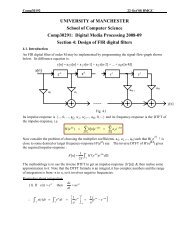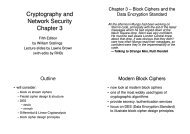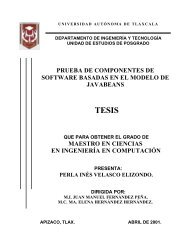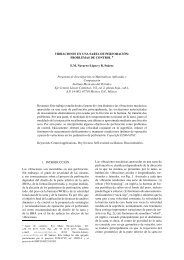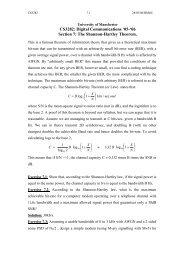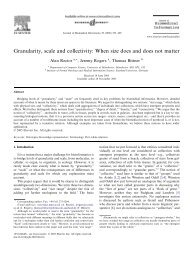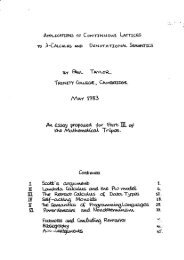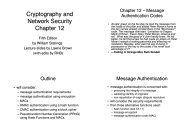Towards a Parallelising COBOL Compiler - Computer Science - The ...
Towards a Parallelising COBOL Compiler - Computer Science - The ...
Towards a Parallelising COBOL Compiler - Computer Science - The ...
You also want an ePaper? Increase the reach of your titles
YUMPU automatically turns print PDFs into web optimized ePapers that Google loves.
Proceedings of the 14th IASTED International Conference on Applied Informatics (Innsbruck, Feb. 1996),<br />
IASTED-ACTA Press, pp. 190–192.<br />
Abstract<br />
<strong>Towards</strong> a <strong>Parallelising</strong> <strong>COBOL</strong> <strong>Compiler</strong><br />
Rizos Sakellariou and Michael O’Boyle<br />
Department of <strong>Computer</strong> <strong>Science</strong>, University of Manchester<br />
Manchester M13 9PL, United Kingdom<br />
This paper briefly describes some of the fundamental<br />
issues in developing an automatic parallelising <strong>COBOL</strong><br />
compiler. <strong>The</strong> rationale for such a tool and its connection<br />
with research in scientific computing is described. This is<br />
followed by an account of the useful forms of parallelism<br />
to be found in a <strong>COBOL</strong> program and how they may be<br />
detected using dependence analysis. Finally, transformations<br />
to uncover parallelism and how this can be mapped<br />
onto a parallel architecture are outlined.<br />
Key words: Automatic parallelisation, parallel <strong>COBOL</strong>.<br />
1 Introduction<br />
Parallel computing has received considerable interest as<br />
a means of obtaining increased computer performance.<br />
In order to overcome the difficulties associated with<br />
programming parallel computers, parallelising compilers<br />
have been promoted as a means of emancipating the programmer<br />
from this task [1, 2]. In its full concept, a parallelising<br />
compiler accepts as an input a sequential program<br />
and transforms it to a parallel one tailored to the<br />
requirements of a specific parallel architecture. This process,<br />
known as automatic parallelisation [3], can be regarded<br />
as a mainly two stage process: in the first stage the<br />
compiler identifies modules which can be run in parallel<br />
and applies program restructuring transformations to improve<br />
program’s performance. <strong>The</strong> result of this phase is<br />
a semantically equivalent parallel program, which, in the<br />
second stage, is mapped onto a parallel architecture.<br />
Most of the current research in automatic parallelisation<br />
has been targeted around the parallelism encountered<br />
in FORTRAN-like loop structures, i.e. parallelism which<br />
results from the repeated execution of the same instructions<br />
on different data; this is known as the data parallel<br />
paradigm [4]. Our motivation for this paper stems from<br />
the fact that <strong>COBOL</strong> programs perform a similar process;<br />
in many cases a set of identical program actions are applied<br />
to a large number of data records. Given the high<br />
number of <strong>COBOL</strong> program lines currently in use and the<br />
slow transition of existing code to more potentially effi-<br />
cient programming paradigms, such as the object-oriented<br />
[5], automatic parallelisation of existing programs may<br />
provide an alternative source of increasing performance.<br />
Considerable research has been directed into parallelising<br />
SQL statements [6]; these results may be used for<br />
the parallelisation of <strong>COBOL</strong> programs making access to<br />
database files, however, not all programs include this option.<br />
Some preliminary work in identifying those characteristics<br />
amenable to parallelism has been described in<br />
[7].<br />
In this paper we attempt to transplant experience drawn<br />
from the development of a parallelising compiler for FOR-<br />
TRAN programs [8] into <strong>COBOL</strong> and our objective is to<br />
highlight the feasibility of a parallelising <strong>COBOL</strong> compiler.<br />
Issues concerning the parallelism encountered in<br />
<strong>COBOL</strong> programs and its detection and mapping onto a<br />
parallel architecture are discussed.<br />
2 Parallelism Detection<br />
Two types of parallelism are usually found in computer<br />
programs written in conventional sequential languages:<br />
task parallelism results from the concurrent execution of<br />
different parts of a program, while data parallelism results<br />
from the concurrent execution of the same program<br />
statements on different elements of data.<br />
<strong>COBOL</strong> applications are characterised by the need of<br />
handling large amounts of data; thus, although task parallelism<br />
may be present, we confine our discussion to the<br />
detection of data parallelism. We distinguish between<br />
three different types: file parallelism exists when running<br />
the same program using different files; record parallelism<br />
refers to the parallelism encountered when processing different<br />
records of the same file, for instance as a result<br />
of reading a master file to print a name list; and array<br />
parallelism is associated with the parallelism existing on<br />
computations involving arrays. A distinction is also made<br />
for the parallelisation of certains constructs like SORT or<br />
SEARCH which can be parallelised by means of appropriately<br />
written external library routines; for instance, a parallel<br />
sorting algorithm is described in [9]. From a compiler<br />
point of view, interest is focused on the first two<br />
forms of parallelism.
A necessary requirement for the parallelised program is<br />
to preserve the semantics of the original sequential program;<br />
thus, two statements can be executed in parallel<br />
only if there is no relationship between them which places<br />
constraints on their execution order. Such constraints are<br />
identified by means of a data dependence analysis [3]. In<br />
our case, it is important to identify dependences between<br />
different loop iterations (loop-carried dependences). Assuming<br />
than an iteration i1 precedes an iteration i2 then<br />
three types of data dependence may exist: a data flow<br />
dependence denotes that a variable which is computed<br />
(written) in iteration i1 is read in iteration i2; a data antidependence<br />
denotes that a variable which is read in iteration<br />
i1 is computed in iteration i2; and a data output dependence<br />
denotes a variable which is computed in both i1<br />
and i2.<br />
To illustrate the above, consider the code fragment<br />
shown below, which implements the process of updating<br />
an indexed master file from a sequential transaction file:<br />
...<br />
MOVE "N" TO END-FILE.<br />
PERFORM P500-UPDATE UNTIL END-FILE="Y".<br />
...<br />
P500-UPDATE.<br />
READ TRANS AT END MOVE "Y" TO END-FILE.<br />
IF END-FILE NOT = "Y"<br />
(...read master according to trans-rec<br />
update master-rec fields...)<br />
WRITE MASTER-REC.<br />
<strong>The</strong> repeated executions of the P500 paragraph define a<br />
loop; the objective is to examine whether any record parallelism<br />
may be exploited by assigning different iterations<br />
on different processors. Clearly, the scalars representing<br />
the fields of the master record define a data output dependence,<br />
since they are computed in any two iterations of the<br />
loop, while the scalars representing the fields of the transaction<br />
record define a data anti-dependence; applying a<br />
technique known as privatisation [3], where each processor<br />
has its own copy of the variables, both output and anti<br />
dependences can be removed. Thus, parallelism may be<br />
constrained by data-flow dependences which, in our example,<br />
may arise when a record of the master file which<br />
has been written in an earlier iteration is read again by a<br />
subsequent iteration; this possibility may be eliminated if<br />
there are not any two records of the transaction file referring<br />
to the same record of the master file. If this is not<br />
the case, then updates to the same record of the master file<br />
must be executed by the same processor or a synchronisation<br />
mechanism must safeguard the order of the execution.<br />
Sorting the transaction file before updating the master file<br />
may also provide a solution whenever there are multiple<br />
records in the transaction file referring to the same record<br />
of the master file; then, the transaction file may be split<br />
into subfiles, with no two of them referring to the same<br />
record of the master file, and exploit file parallelism.<br />
In general, by viewing <strong>COBOL</strong> files as arrays (where the<br />
first record of a file is the first element of an array, and so<br />
on), the abstract representation framework and the techniques<br />
used in the context of scientific applications can<br />
be also applied here. <strong>The</strong> additional requirement posed is<br />
that in certain cases, as in the previous example to ensure<br />
that there are no data-flow dependences, some knowledge<br />
on the value of the records may also be needed; this may<br />
be a complicated issue in the case of loops performing operations<br />
on several master files. However, it appears that<br />
for programs involving sequential operations on files, their<br />
parallelisation is straightforward.<br />
3 Optimising Transformations<br />
It may not be always possible for the compiler to detect<br />
directly the parallelism present in programs. Assume, for<br />
instance, that the example code illustrated in the previous<br />
section was written as:<br />
...<br />
READ TRANS AT END MOVE "Y" TO END-FILE.<br />
PERFORM P500-UPDATE UNTIL END-FILE="Y".<br />
...<br />
P500-UPDATE.<br />
(...read master according to trans-rec<br />
update master-rec fields...)<br />
WRITE MASTER-REC.<br />
READ TRANS AT END MOVE "Y" TO END-FILE.<br />
<strong>The</strong>n, the scalars representing the fields of the transaction<br />
record show a data flow dependence since they are getting<br />
values (READ statement) at the iteration preceding the one<br />
where they are used. To uncover the parallelism, the compiler<br />
must be able to restructure the source code to the<br />
form shown earlier; similar transformations to eliminate<br />
dependences have been studied in the context of arraybased<br />
scientific codes [3]. Restructuring may also involve<br />
a series of transformations to increase the functionality of<br />
the source code, such as the removal of GO TO statements<br />
[10].<br />
It must be noted though that any restructuring transformations<br />
should be applied subject to increasing program’s<br />
execution time. <strong>The</strong> latter, i.e. the execution time of the<br />
parallel program, tp, can be modelled as tp = to + ts/p,<br />
where to is the time spent on overheads due to parallel<br />
execution, ts is the time needed to execute the program<br />
sequentially, and p is the number of processors used in<br />
the parallel implementation; overheads may be primarily<br />
due to communication or synchronisation requirements,<br />
and/or load imbalance [8]. Usually, parallelism trades off<br />
against overheads; thus an attempt to uncover parallelism<br />
may increase some other sources of overhead. Using this<br />
model, the parallelising compiler must decide whether the<br />
parallelisation of a code may result in a faster execution<br />
time (i.e. tp < ts). For instance, assuming that a synchronisation<br />
mechanism is used to safeguard the order of execution<br />
in the example of the previous section, the time<br />
that the processors spent waiting to acquire a lock should<br />
be less than ts(1 − 1/p) in order to have faster execution<br />
time. Further issues on modelling these overheads are discussed<br />
in [11].
4 Mapping<br />
In the mapping phase, the parallelism available is mapped<br />
onto processors in such a way that overheads are minimised.<br />
<strong>The</strong> approaches traditionally used for DO..ENDDO<br />
type of loops in scientific applications are either to assign<br />
a specific number of iterations to each processor (loop<br />
partitioning) or to distribute the data amongst processors<br />
(data partitioning) and then having each processor computing<br />
the values of the data it owns (owner-computes<br />
rule); the former approach is usually preferable on shared<br />
memory and the latter on distributed memory parallel<br />
computers. In the case of <strong>COBOL</strong> programs, where data<br />
reside on a disk, analogies can be drawn with the shareddisk<br />
and shared-nothing paradigms respectively, which<br />
are employed in parallel database technology [6, 9].<br />
Using a shared-nothing model, parallelism may be exploited<br />
by splitting the data files into subfiles which are<br />
stored in a disk assigned to a particular processor (file<br />
parallelism). In order to reduce any communication overheads<br />
it is essential that all the records which are accessed<br />
at the same loop iteration are located in the same disk. In<br />
several cases this may not be possible and an algorithm to<br />
reduce any transfers should be devised; such an algorithm<br />
is expected to be a simplified version of algorithms used<br />
to minimise overheads for FORTRAN programs as the one<br />
outlined in [8]. Considering the code fragment shown in<br />
section 2, sorting and splitting the transaction file into subfiles<br />
of equal size and storing them in the same disk with<br />
subfiles of the master file which has been split (assuming<br />
it is sorted as the transaction file) at the points where<br />
the transaction file is split, may provide a communicationfree<br />
parallel execution. However, the sorting and splitting<br />
phases pose an overhead which should be considered by<br />
the compiler before these phases are applied (cf section<br />
3).<br />
In a shared-disk model, loop iterations can be assigned<br />
in a round-robin fashion to processors, or they may be<br />
assigned to the first idle processor. While both these<br />
strategies guarantee a fair distribution of the workload<br />
amongst processors, they may suffer from extensive I/O<br />
contention. Thus, it is preferable to assign consecutive<br />
loop iterations to each processor; considering again the<br />
example presented in section 2, this approach ensures<br />
that there will be no ‘interleaving’ in the way that processors<br />
access the records of the transaction file. However,<br />
in order to partition the iterations as evenly as possible,<br />
it is necessary to know their total number; knowing<br />
the file size, f , and the record size, r, of the transaction<br />
file and assuming that p processors are available,<br />
each processor is allocated approximately f /rp iterations.<br />
Thus, the PERFORM..UNTIL construct may be treated as a<br />
PERFORM..N TIMES, where N= f /r; then, the first processor<br />
executes iterations 1 through n/p, in general processor<br />
i executes iterations (i − 1)n/p + 1 through in/p (assuming<br />
that p divides n).<br />
From an abstract point of view, the process of mapping<br />
data located in a disk can be modelled by means of a<br />
memory hierarchy model where disk access is associated<br />
with the most expensive level in the hierarchy. A possible<br />
way of minimising these costs would be to move blocks<br />
which are more often accessed (e.g. the records of a master<br />
file) to a less expensive level; this strategy, also discussed<br />
in [7], needs careful consideration in the selection<br />
of the blocks to avoid continuous transfers back and forth.<br />
5 Concluding Remarks<br />
This paper forms the starting point of our research into<br />
building an auto-parallelising <strong>COBOL</strong> compiler. Only a<br />
brief outline of the issues involved in parallelising sequential<br />
<strong>COBOL</strong> has been made. It appears that there is a significant<br />
connection with well known techniques applied<br />
for the automatic parallelisation of scientific programs.<br />
Further work is necessary in describing <strong>COBOL</strong> actions in<br />
a representation amenable to analysis, transformation and<br />
parallelisation. <strong>The</strong> impact on data storage and interaction<br />
between applications must also be investigated.<br />
References<br />
[1] M. Wolfe, High Performance <strong>Compiler</strong>s for Parallel Computing<br />
(Addison-Wesley, 1996).<br />
[2] H. Zima, B. Chapman, Supercompilers for Parallel and<br />
Vector <strong>Computer</strong>s (ACM Press, 1990).<br />
[3] U. Banerjee, R. Eigenmann, A. Nicolau, D. Padua, “Automatic<br />
Program Parallelization”, Proceedings of the IEEE,<br />
81 (2), 1993, 211–243.<br />
[4] V. Adve, A. Carle, E. Granston, S. Hiranandani, K.<br />
Kennedy, C. Koelbel, U. Kremer, J. Mellor-Crummey,<br />
S. Warren, “Requirements for Data-Parallel Programming<br />
Environments”, IEEE Parallel & Distributed Technology,<br />
2 (3), 1994, 48–58.<br />
[5] L. J. Pinson, “Moving from <strong>COBOL</strong> to C and C++: OOP’s<br />
biggest challenge”, Journal of Object-Oriented Programming,<br />
7 (6), 1994, 54–56.<br />
[6] D. DeWitt, J. Gray, “Parallel Database Systems: <strong>The</strong> Future<br />
of High Performance Database Systems”, Communications<br />
of ACM, 35 (6), 1992, 85–98.<br />
[7] L. Richter, “Restructuring of Cobol-Applications for<br />
Coarse Grain Parallelization”, Proceedings of the workshop<br />
on Commercial Applications of Parallel Processing<br />
Systems (CAPPS) 93 (Austin, Texas: MCC Technical Corporation,<br />
1993).<br />
[8] F. Bodin, M. O’Boyle, “A <strong>Compiler</strong> Strategy for Shared<br />
Virtual Memories”, in B. K. Szymanski, B. Sinharoy<br />
(eds.), Languages, <strong>Compiler</strong>s and Run-Time Systems for<br />
Scalable <strong>Computer</strong>s (Kluwer Academic Publishers, 1995),<br />
57–69.<br />
[9] A. Kumar, T. Lee, V. Tsotras, “A Load-Balanced Parallel<br />
Sorting Algorithm for Shared-Nothing Architectures”,<br />
Distributed and Parallel Databases, 3 (1), 1995, 37–68.<br />
[10] J. C. Miller, B. M. Strauss III, “Implications of Automated<br />
Restructuring of <strong>COBOL</strong>”, ACM SIGPLAN Notices, 22<br />
(6), 1987, 76–82.<br />
[11] M. E. Crovella, T. J. LeBlanc, “Parallel Performance<br />
Prediction Using Lost Cycles Analysis”, in Proceedings<br />
of Supercomputing ’94 (IEEE <strong>Computer</strong> Society Press,<br />
1994), 600–609.



